Order Catalog Implementation Guide, published by HL7 International / Orders and Observations. This guide is not an authorized publication; it is the continuous build for version 1.0.0-ballot built by the FHIR (HL7® FHIR® Standard) CI Build. This version is based on the current content of https://github.com/HL7/fhir-order-catalog/ and changes regularly. See the Directory of published versions
| Page standards status: Informative |
Contents:
This section presents the examples of catalogs of laboratory diagnostic services. Rather than showing full details of the resources built, each example focuses on the key elements illustrating the FHIR design of laboratory catalogs. The full details for each resource built can be viewed in the Artifact Index in the Lab examples sections.
The examples are indexed E1, E2, E3, ...
This example illustrates the representation of a simple diagnostic test in the laboratory compendium. The figure below displays the business content.
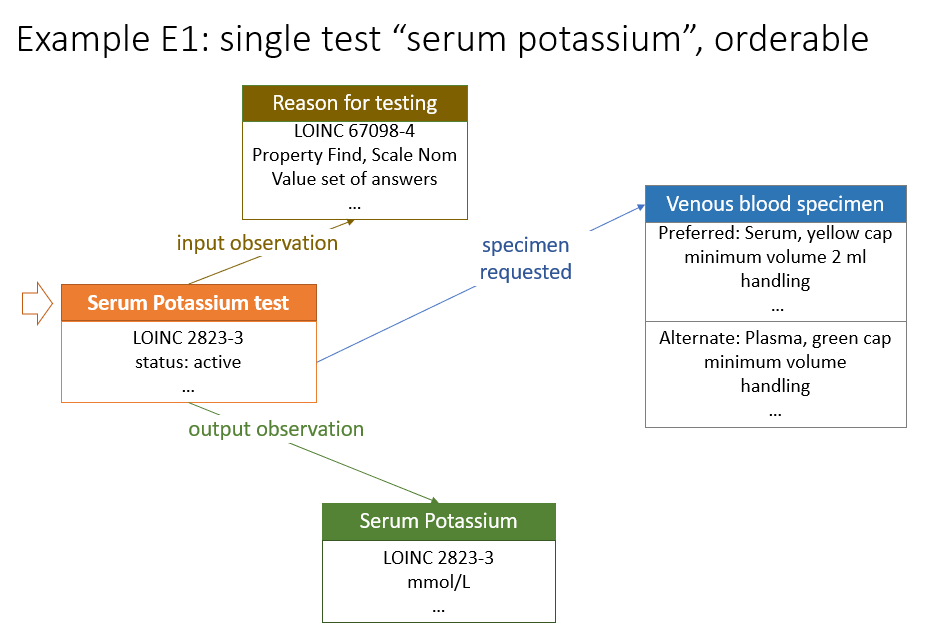
The figure below displays the FHIR technical implementation of the business content.
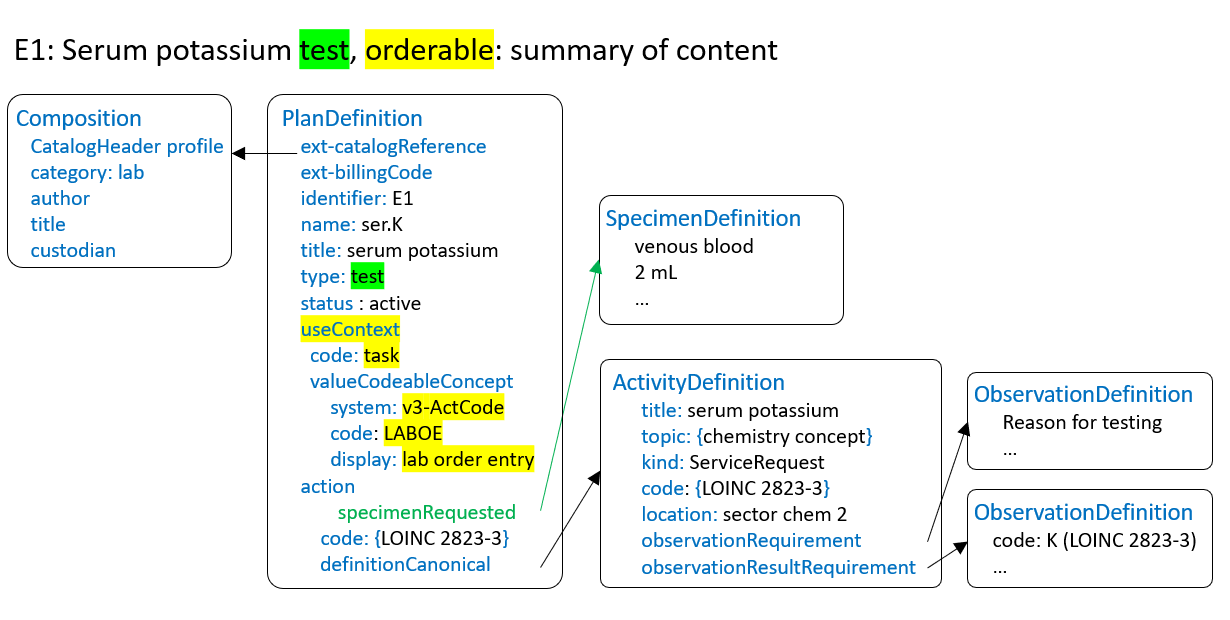
The laboratory service is of type "test". A single test produces usually a single measurement. As shown in this example, the notion of orderability is represented by a predefined context of use: "service associated with laboratory order entry task". A service is orderable if and only if the PlanDefinition representing it includes a useContext element with code = "task" and valueCodeableConcept = "LABOE" (laboratory order entry task) from the V3 ActCode vocabulary.
Artifacts implementing this example:
| Business content | Base resource | Profile | Example artifact |
|---|---|---|---|
| Laboratory compendium | Composition | CatalogHeader | example-lab-compendium-header |
| Serum potassium - orderable service | PlanDefinition | LabServiceDefinition | example-lab-service-potassium-serum |
| Serum potassium - operational procedure | ActivityDefinition | LabProcedureDefinition | example-lab-procedure-potassium-serum |
| Serum specimen | SpecimenDefinition | LabSpecimenDefinition | example-specimen-venous-serum-single-test |
| Reason for test - input observation | ObservationDefinition | InputObservationDefinition | example-input-observation-reason-for-ordering |
| K serum level - test result | ObservationDefinition | LabObservationDefinition | example-observation-serum-potassium |
This example illustrates the representation of a panel of tests in the laboratory compendium. The figure below displays the business content.
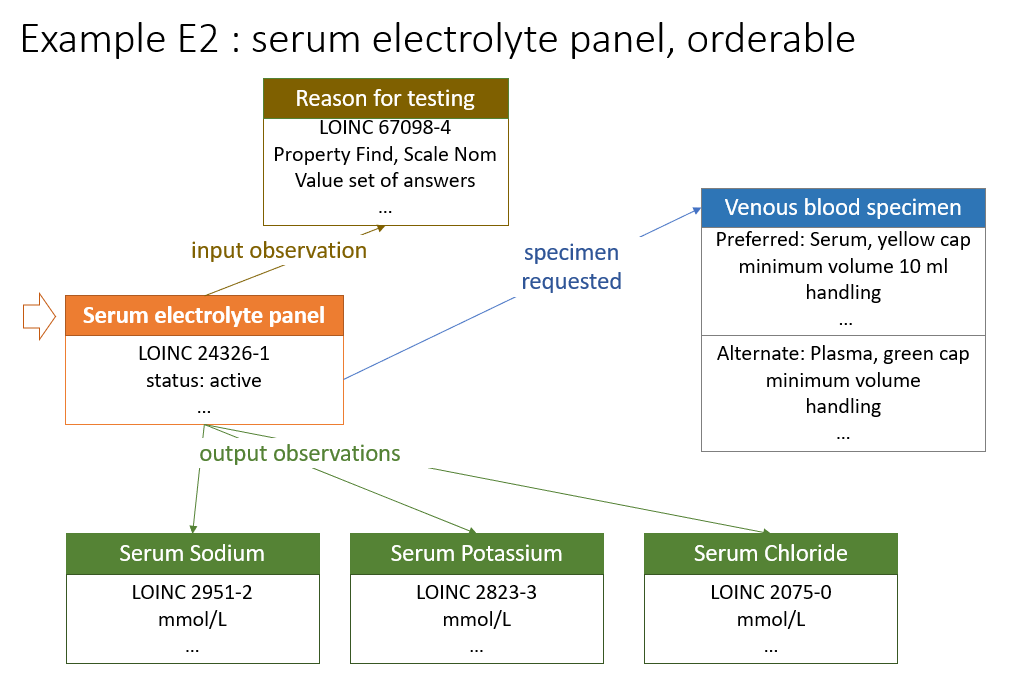
The figure below displays the FHIR technical implementation of the business content.
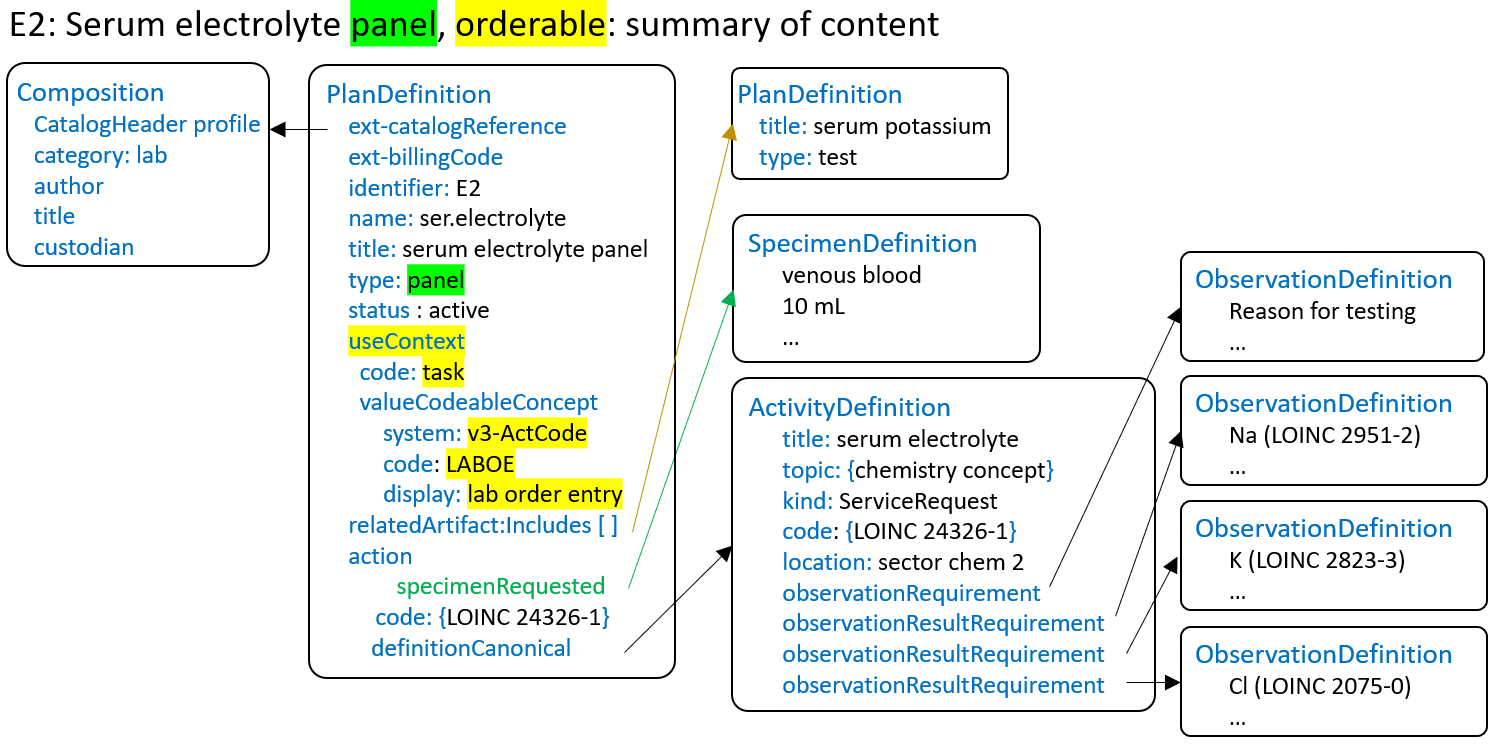
The electrolyte panel E2 includes K on serum also orderable as a single test in example E1. The PlanDefinition references a single electrolyte ActivityDefinition, which references the ObservationDefinition representing the single test from example E1. The PlanDefinition of E2 also includes the PlanDefinition from E1 as related artifact, for informative purpose.
In this example, the laboratory service is of type "panel". A panel is a collection of test of panels, which usually produces multiple results.
Artifacts implementing this example:
This example illustrates the representation of a panel of tests in the laboratory compendium, using some observations both as input and output. The figure below displays the business content.
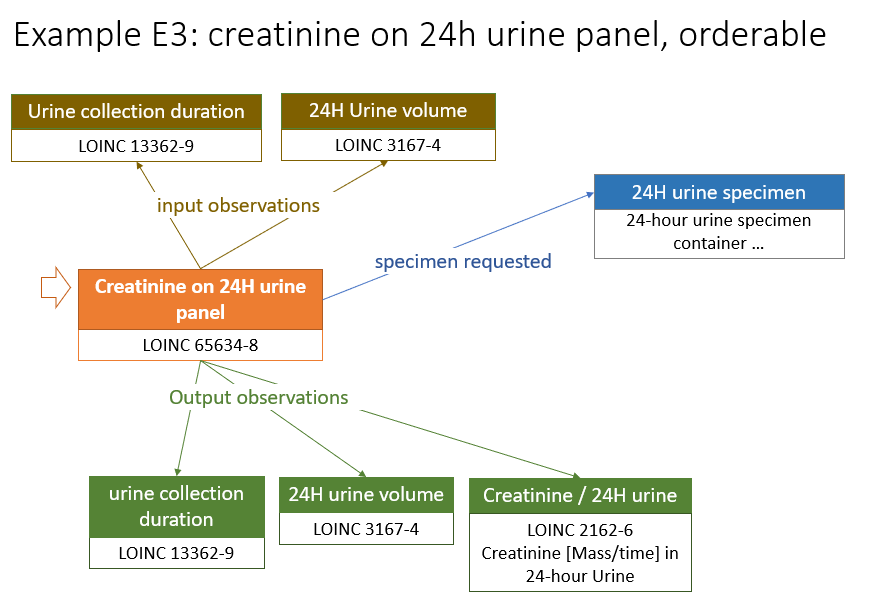
The figure below displays the FHIR technical implementation of the business content.
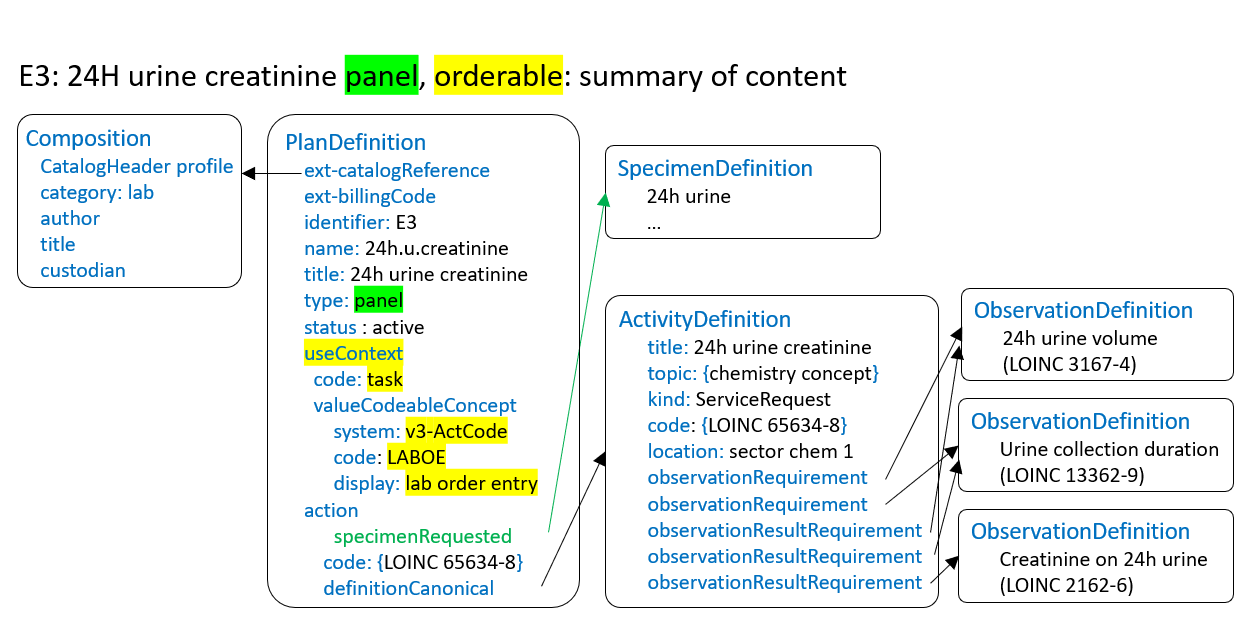
In this example, the laboratory service is of type "panel". A panel is a collection of test of panels, which usually produces multiple results. The observations "24h urine volume" and "urine collection duration" are used both as input (proved by the specimen collector) and as results of the panel.
Artifacts implementing this example:
| Business content | Base resource | Profile | Example artifact |
|---|---|---|---|
| Laboratory compendium | Composition | CatalogHeader | example-lab-compendium-header |
| 24-hour urine creatinine panel - orderable service | PlanDefinition | LabServiceDefinition | example-lab-panel-urine24h-creatinine |
| 24-hour urine creatinine panel - operational procedure | ActivityDefinition | LabProcedureDefinition | example-lab-urine24h-creatinine |
| 24-hour urine specimen | SpecimenDefinition | LabSpecimenDefinition | example-specimen-urine-24h |
| urine collection duration - input/output observation | ObservationDefinition | InputObservationDefinition | example-observation-collection-duration |
| LabObservationDefinition | |||
| 24-hour urine volume - input/output observation | ObservationDefinition | InputObservationDefinition | example-observation-collection-volume |
| LabObservationDefinition | |||
| 24-hour urine creatinine - lab result | ObservationDefinition | LabObservationDefinition | example-observation-urine24h-creatinine |
This example illustrates the representation of a laboratory service using two alternative kinds of specimens. The figure below displays the business content.
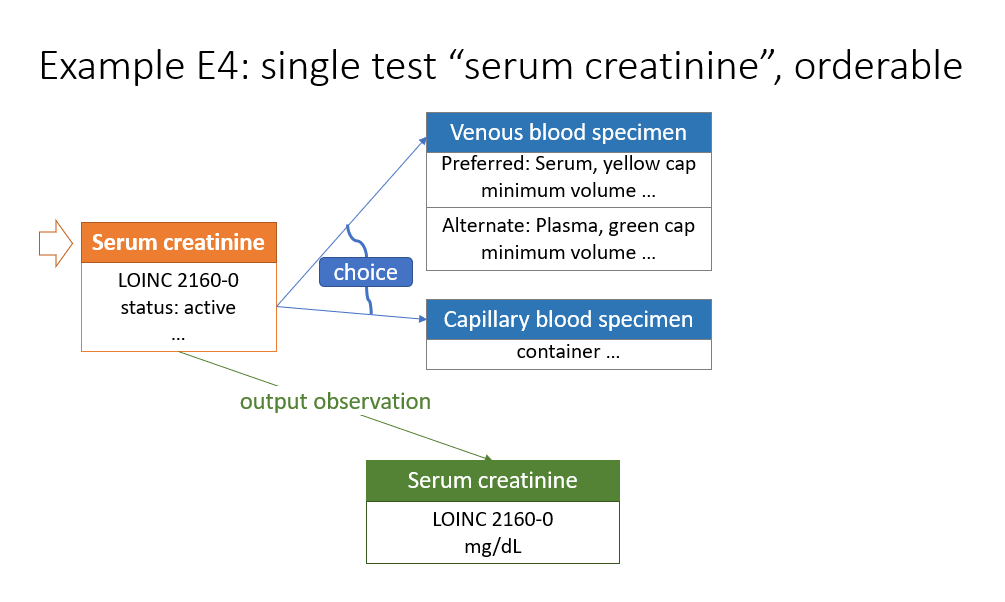
The figure below displays the FHIR technical implementation of the business content.
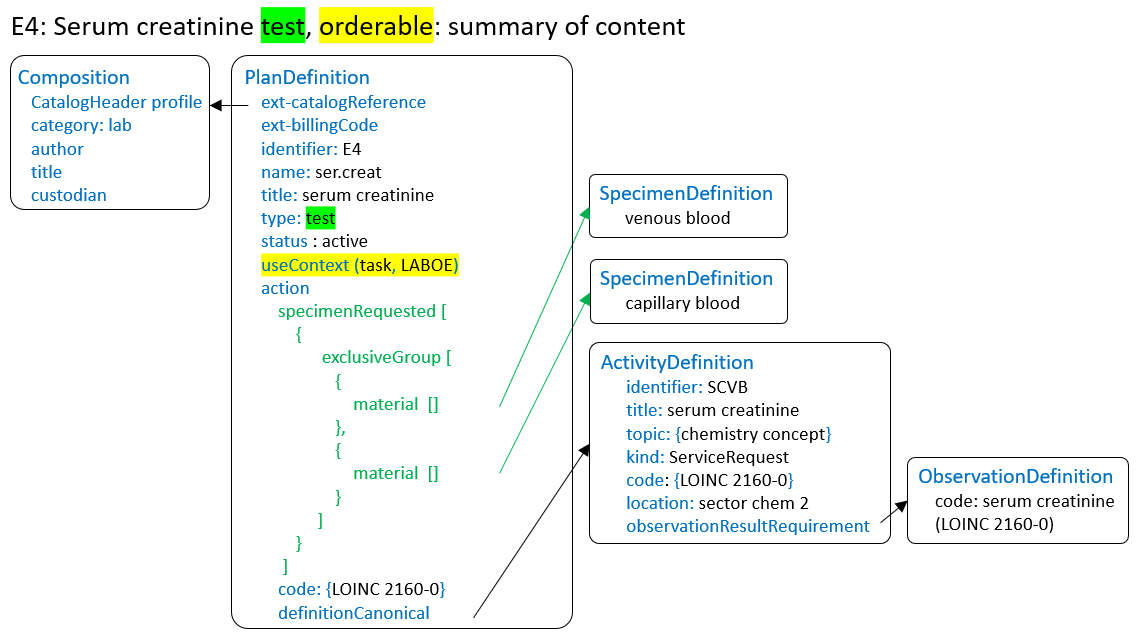
In this example, the laboratory service is of type "test" and is expected to produce an single result; the serum/plasma creatinine level. The service is operationalized by two alternative procedures (ActivityDefinition) depending of the kind of specimen collected. Both procedures produce the same observation "serum creatinine"
Artifacts implementing this example:
| Business content | Base resource | Profile | Example artifact |
|---|---|---|---|
| Laboratory compendium | Composition | CatalogHeader | example-lab-compendium-header |
| serum/plasma creatinine - orderable service | PlanDefinition | LabServiceDefinition | example-lab-test-serum-creatinine |
| serum/plasma creatinine operational procedure | ActivityDefinition | LabProcedureDefinition | example-lab-procedure-serum-creatinine |
| capillary blood serum/plasma specimen | SpecimenDefinition | LabSpecimenDefinition | example-specimen-capillary-serum-single-test |
| venous blood serum/plasma specimen | SpecimenDefinition | LabSpecimenDefinition | example-specimen-venous-serum-single-test |
| serum/plasma creatinine - lab result | ObservationDefinition | LabObservationDefinition | example-observation-serum-creatinine |
This example illustrates how a panel can logically include a combination of tests and panels, using logical AND and XOR to assemble them. The figure below displays the business content.
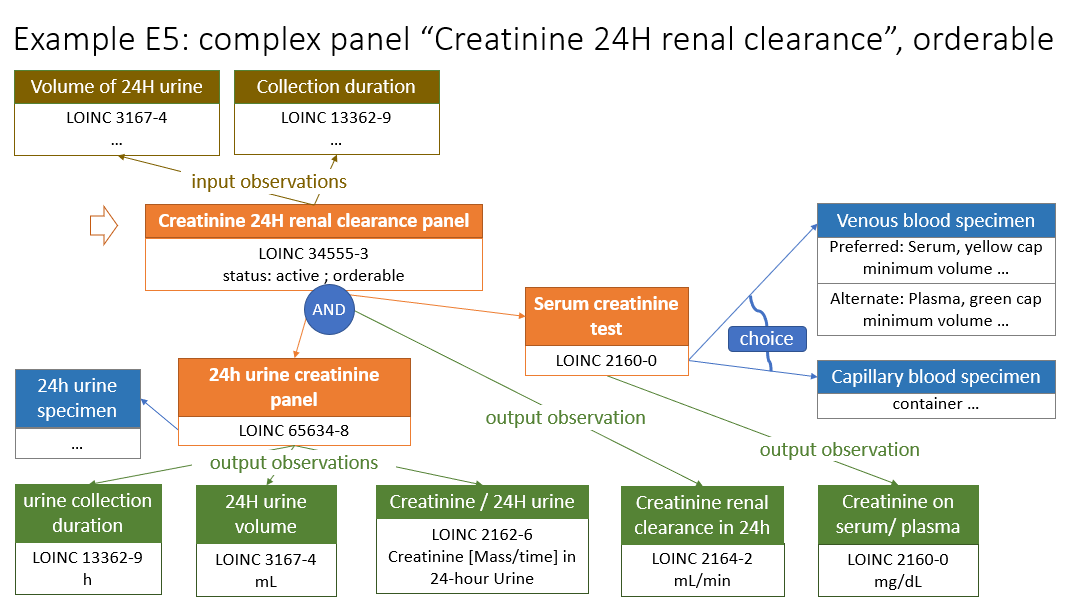
The figure below displays the FHIR technical implementation of the business content.
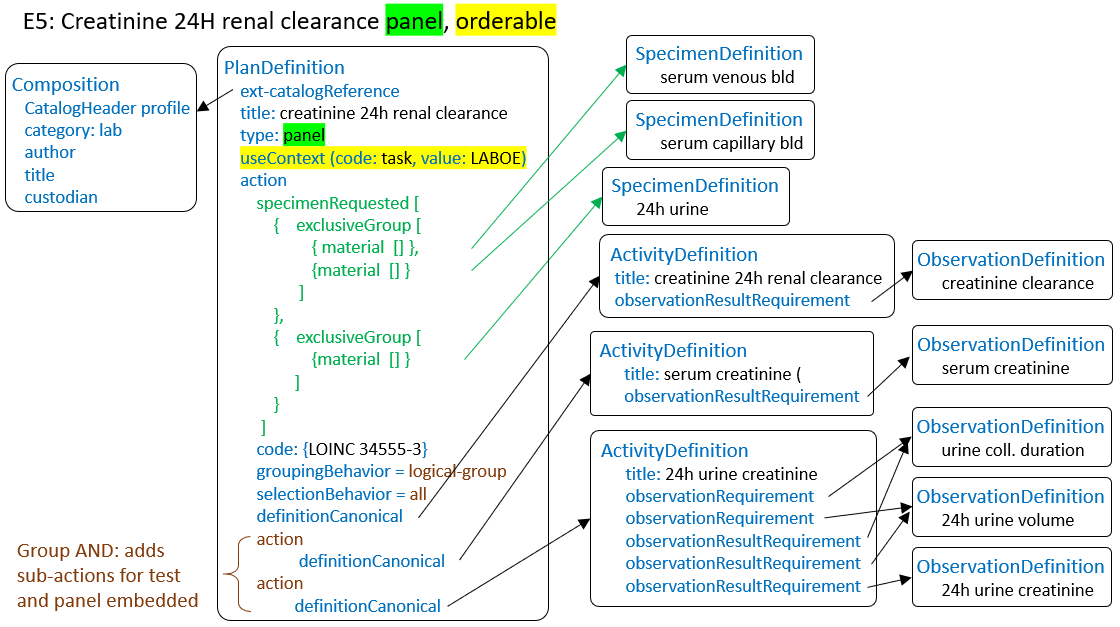
In this example, the laboratory service is of type "panel" it assembles two other panels and one single test.
Artifacts implementing this example:
This example illustrates the representation of a simple diagnostic test in the laboratory compendium, associated with a billing code and billing rules. The example is in French as is the billing coding system.
The figure below displays the business content.
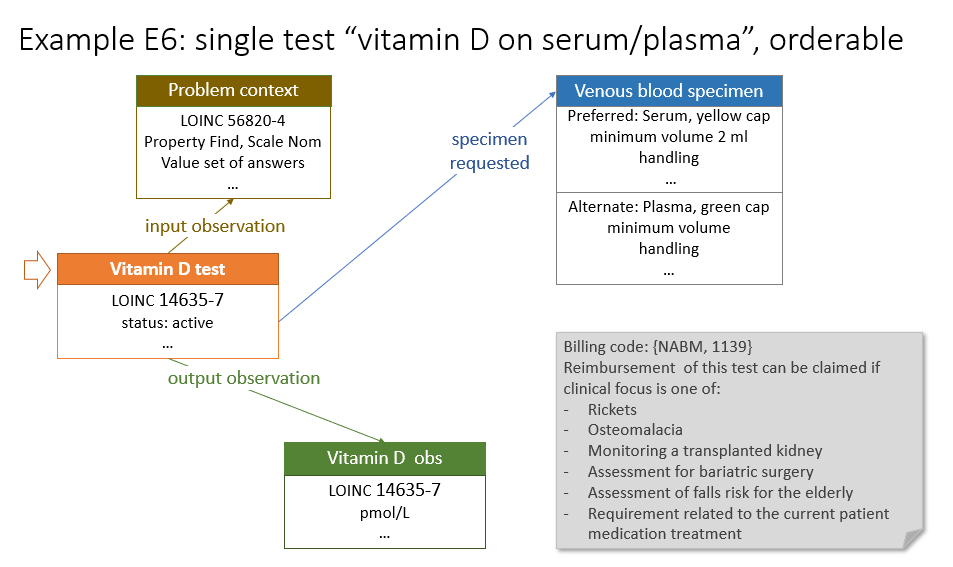
The figure below displays the FHIR technical implementation of the business content.
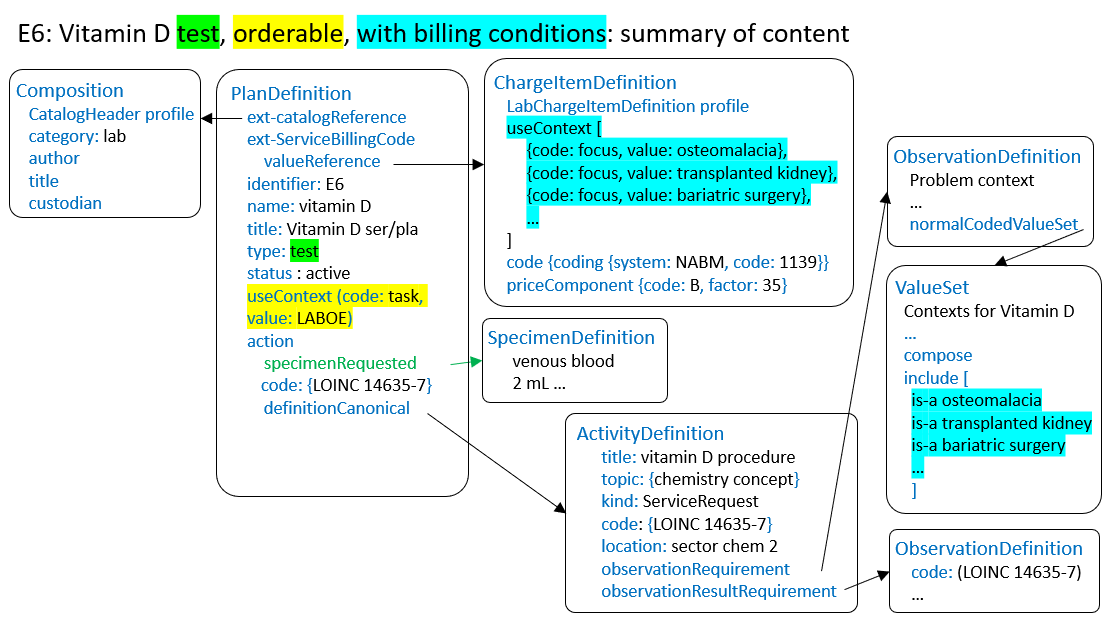
The laboratory service is of type "test". A single test produces usually a single measurement. This service can be claimed for reimbursement only if it is ordered with a clinical context that matches one of the clinical focuses declared in the ChargeItemDefinition referenced by the service.
Artifacts implementing this example:
| Business content | Base resource | Profile | Example artifact |
|---|---|---|---|
| Laboratory compendium | Composition | CatalogHeader | example-lab-compendium-header |
| Vitamin D - orderable service | PlanDefinition | LabServiceDefinition | example-lab-service-vitamind-serum |
| Vitamin D - billing code and conditions | ChargeItemDefinition | LabChargeItemDefinition | example-lab-billing-vitamind-focus |
| Vitamin D - operational procedure | ActivityDefinition | LabProcedureDefinition | example-lab-procedure-vitamind-serum |
| Serum specimen | SpecimenDefinition | LabSpecimenDefinition | example-specimen-venous-serum-single-test |
| Clinical contexts for test - input observation | ObservationDefinition | InputObservationDefinition | example-input-observation-context-for-vitamin-d |
| Normal Contexts for Vitamin D Test | ValueSet | example-normal-contexts-vitamin-d | |
| All contexts possibly associated with Vitamin D Test | ValueSet | example-clinical-focus | |
| Vitamin D level - test result | ObservationDefinition | LabObservationDefinition | example-observation-vitamin-d |
This example illustrates the representation of a super-panel embedding two single tests orderable individually and two sub-panels also orderable individually, one of which embeds two reflex tests (also orderable themselves).
The 2 figures below show the business content of the HSV sub-panel having the two reflex tests, and then its FHIR resource representation.
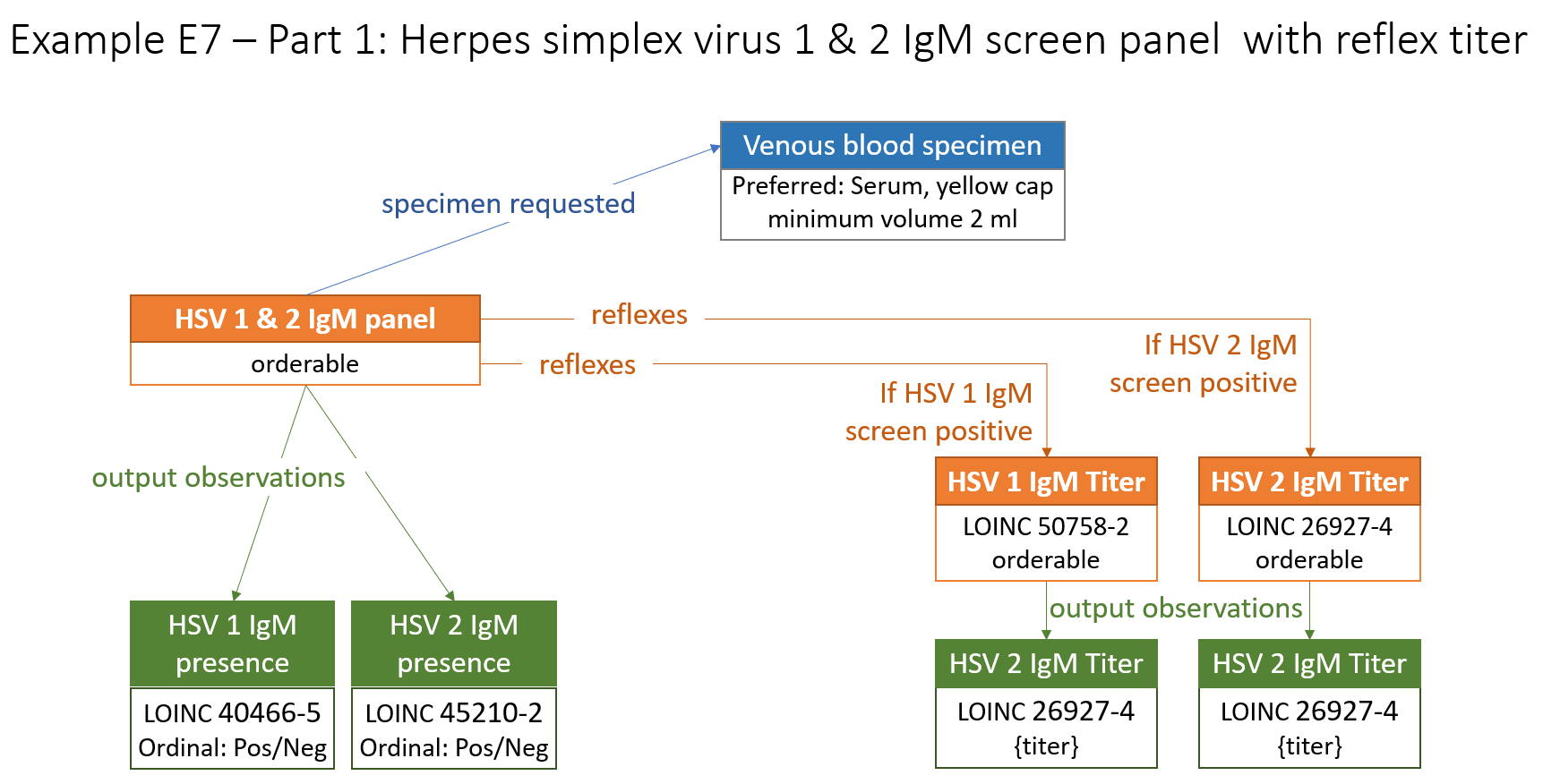
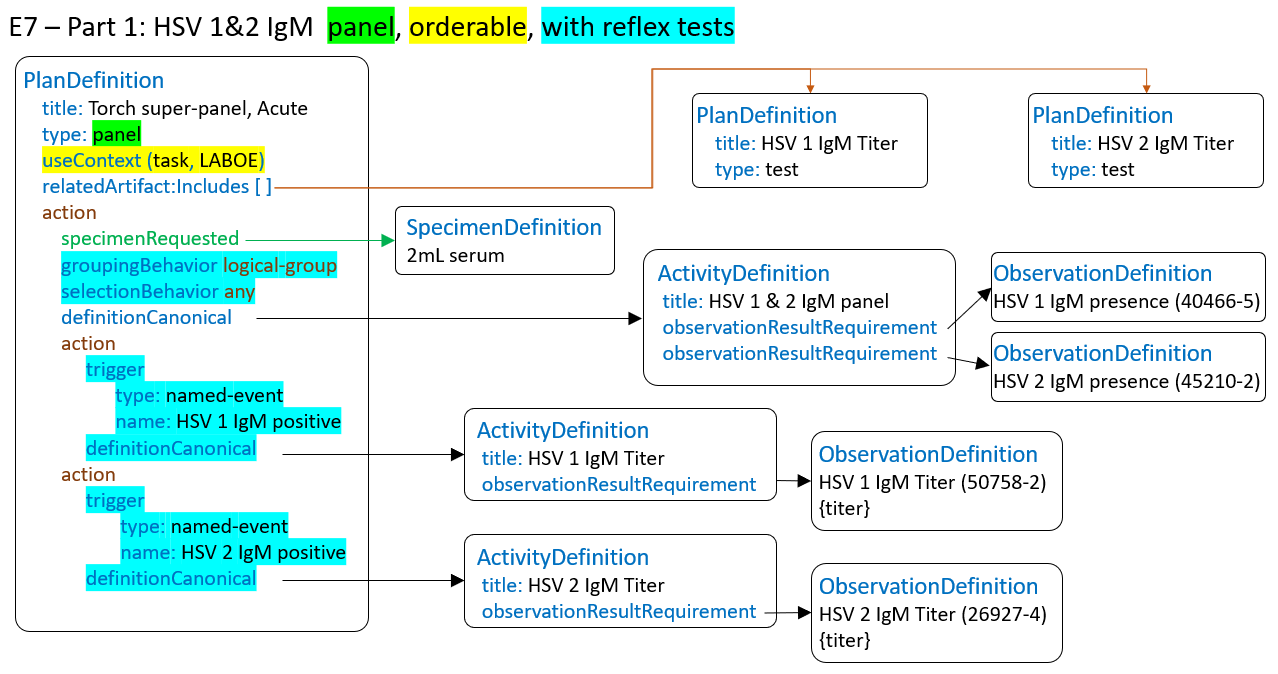
The 2 figures below show the TORCH super-panel, which embeds the HSV sub-panel above. Business content, and then FHIR resource representation:
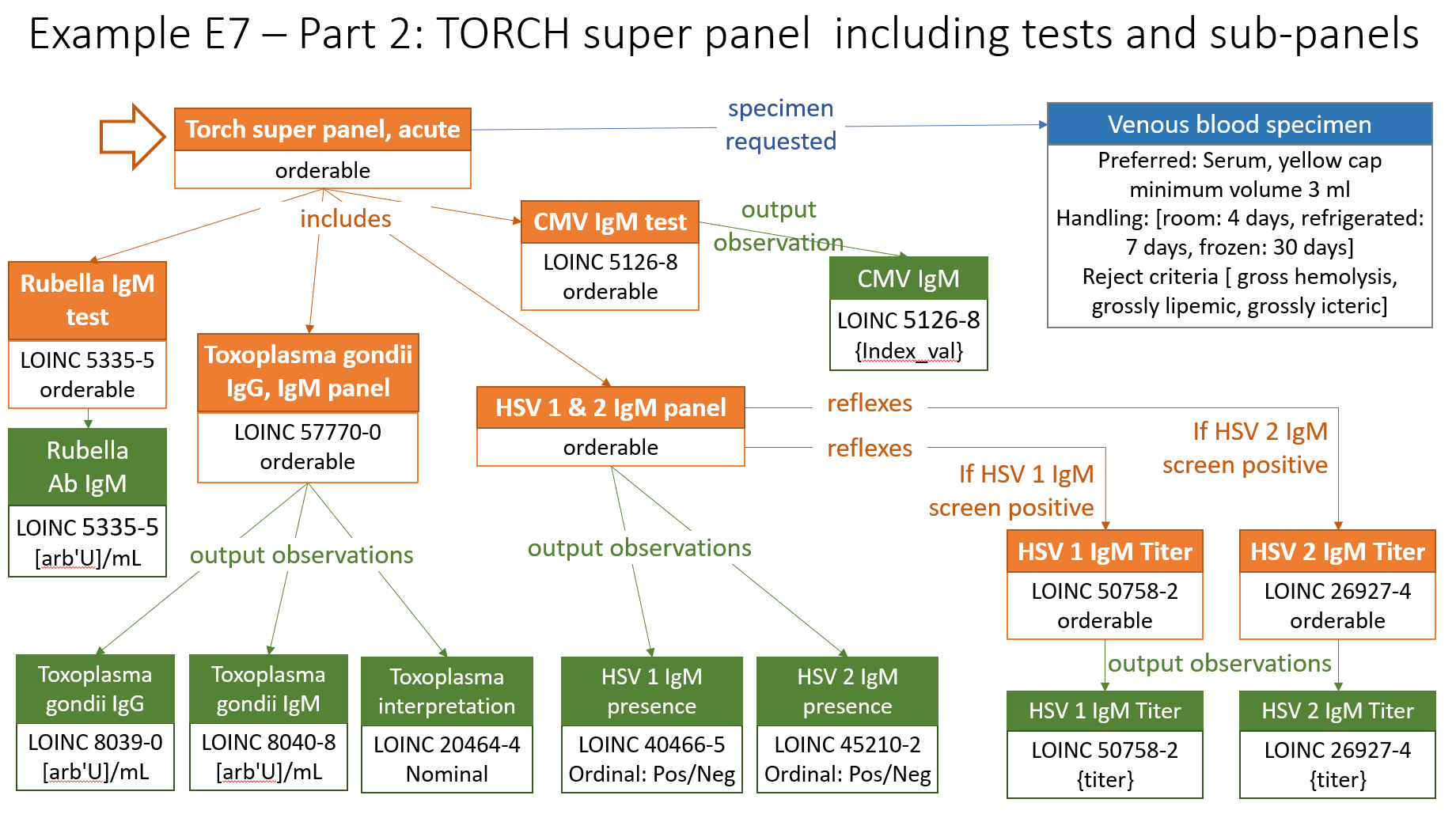

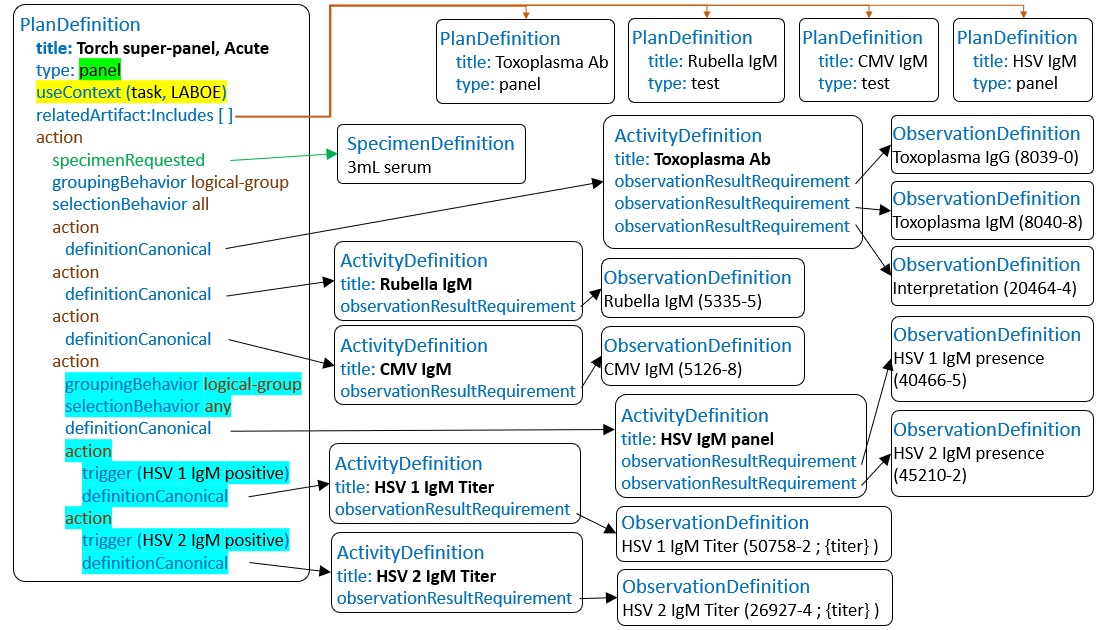
The TORCH laboratory service is of type "panel".
All directly embedded panels and tests are referenced as related artifacts: PlanDefinition.relatedArtifact:Includes (type = composed-of).
Reflex tests are represented as sub-actions grouped in a logical group with behavior "any" meaning that any number of members of the group may be performed. Each sub-action is associated with a trigger conveying the named event, which reflexes it.
Artifacts implementing this example: